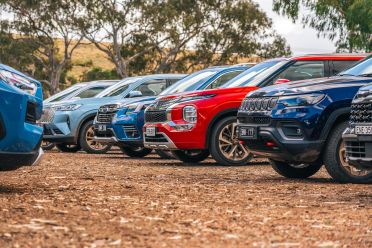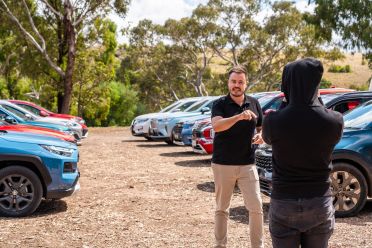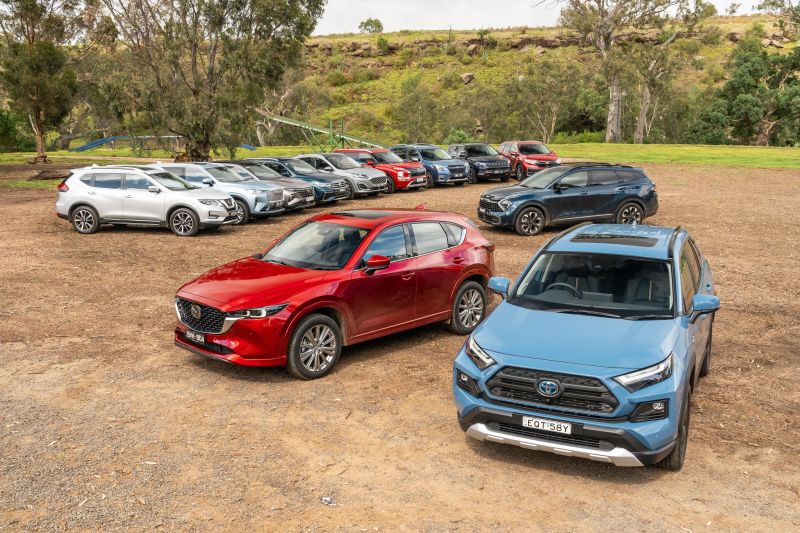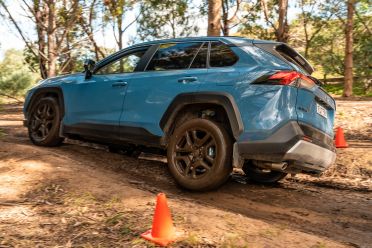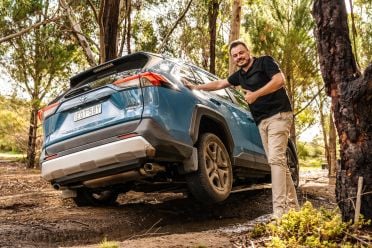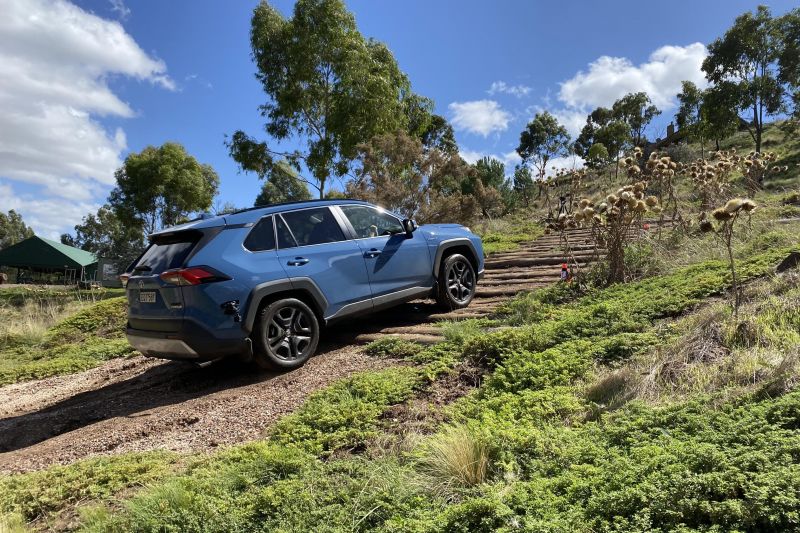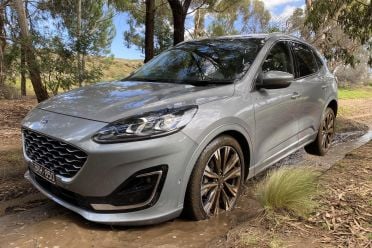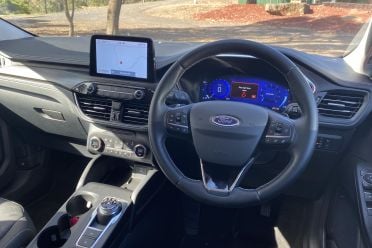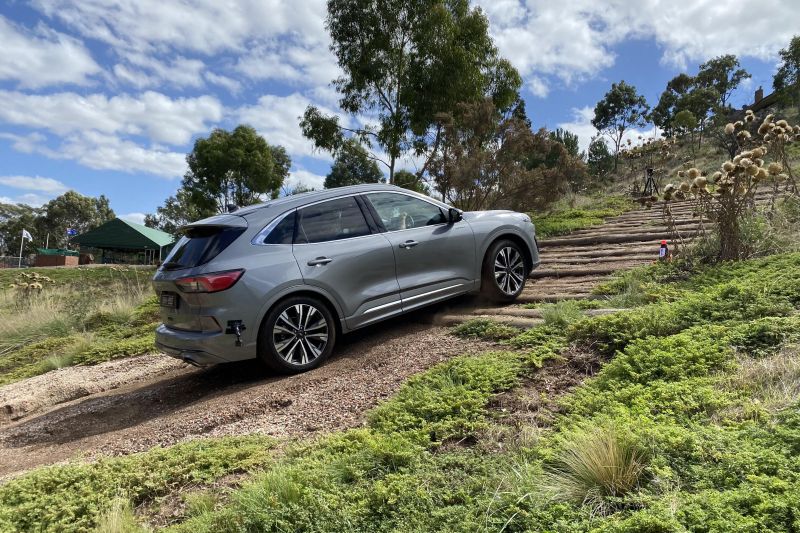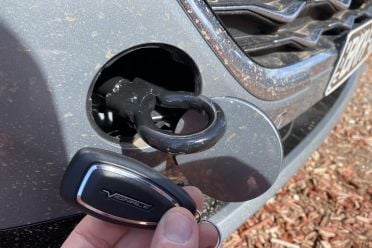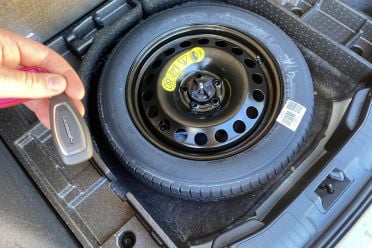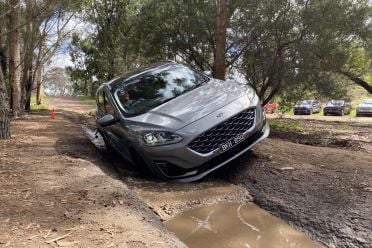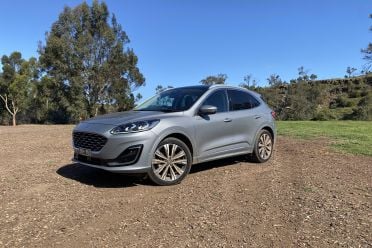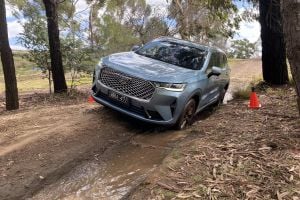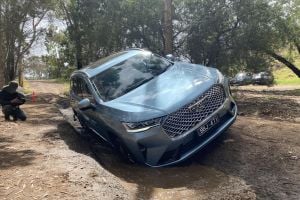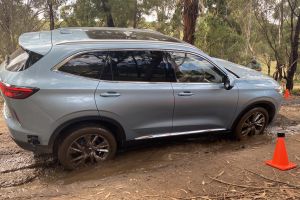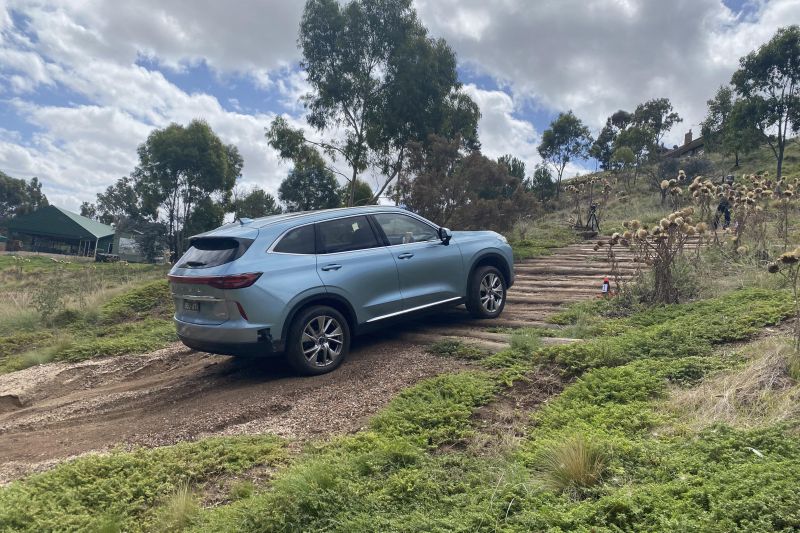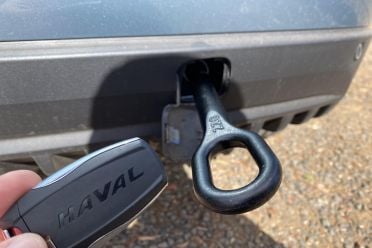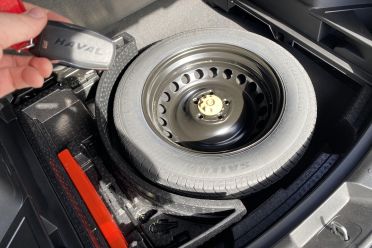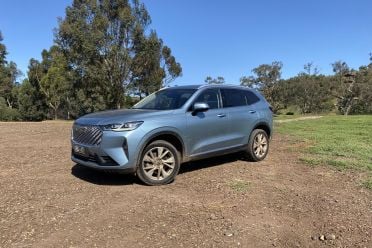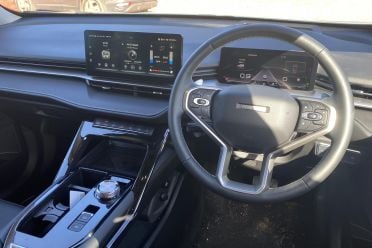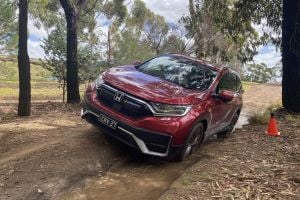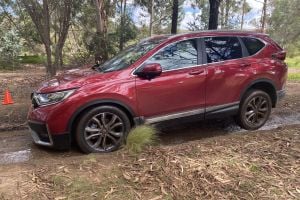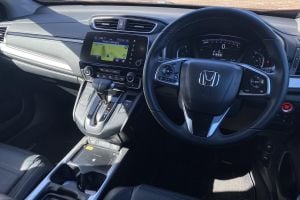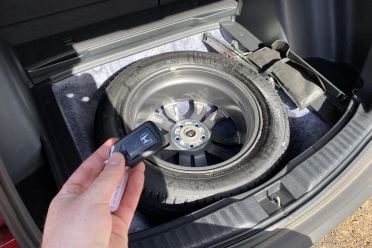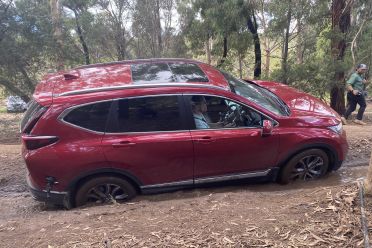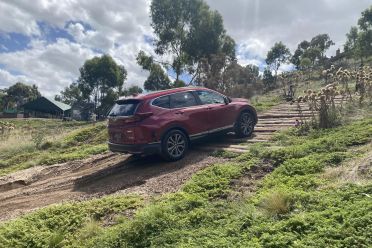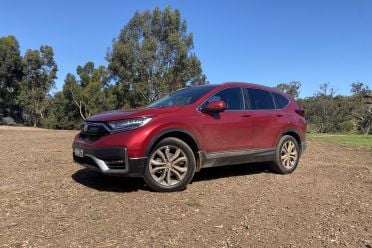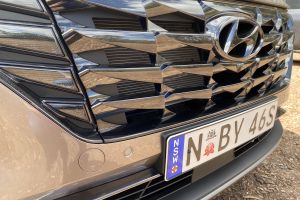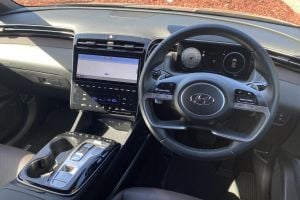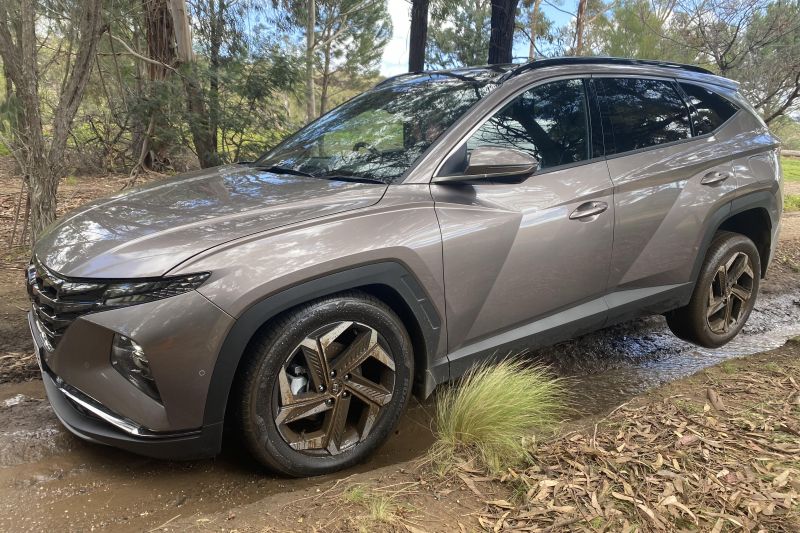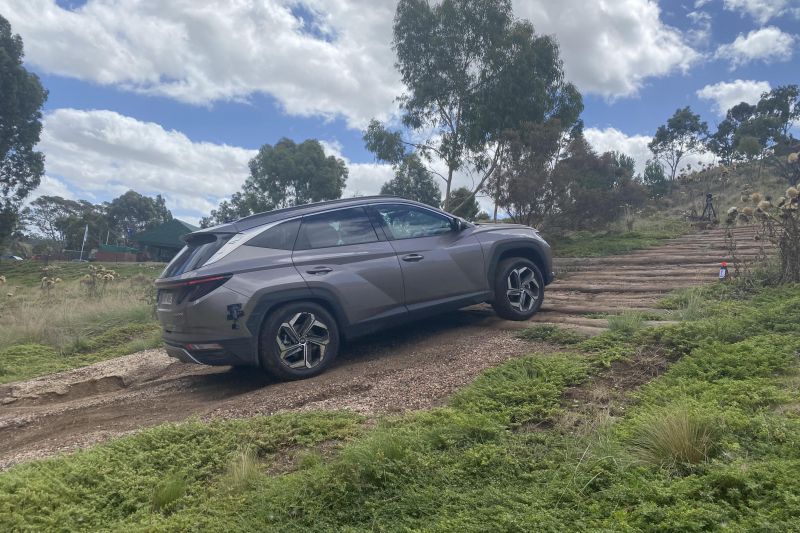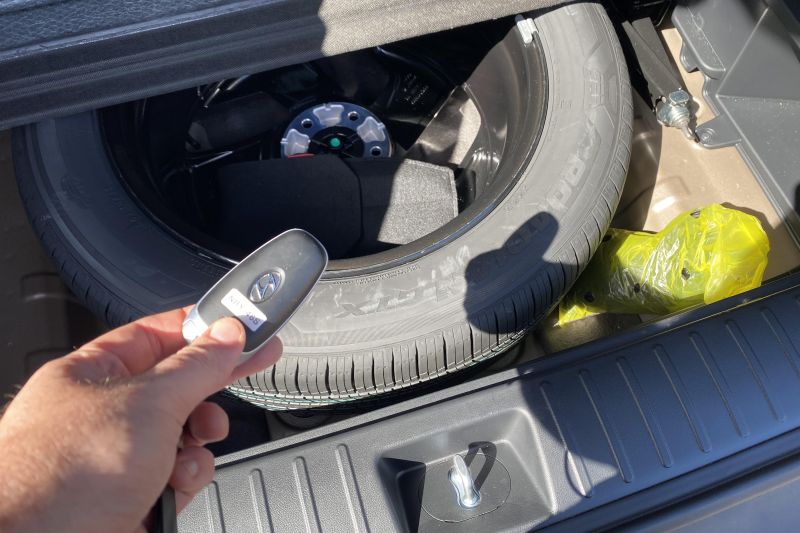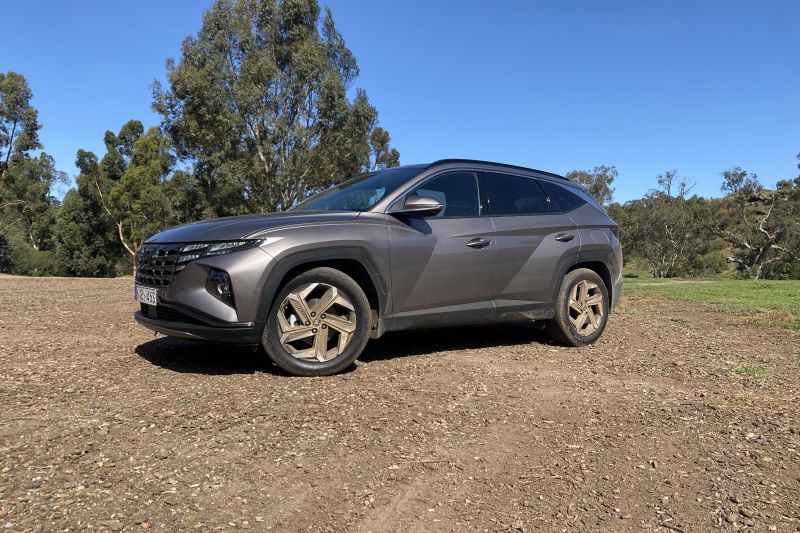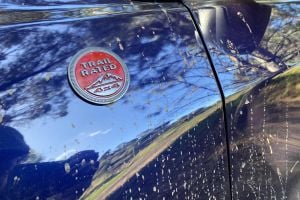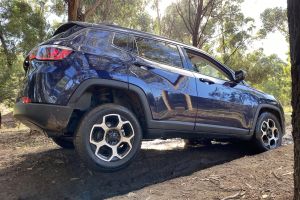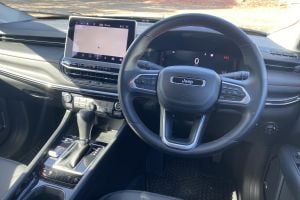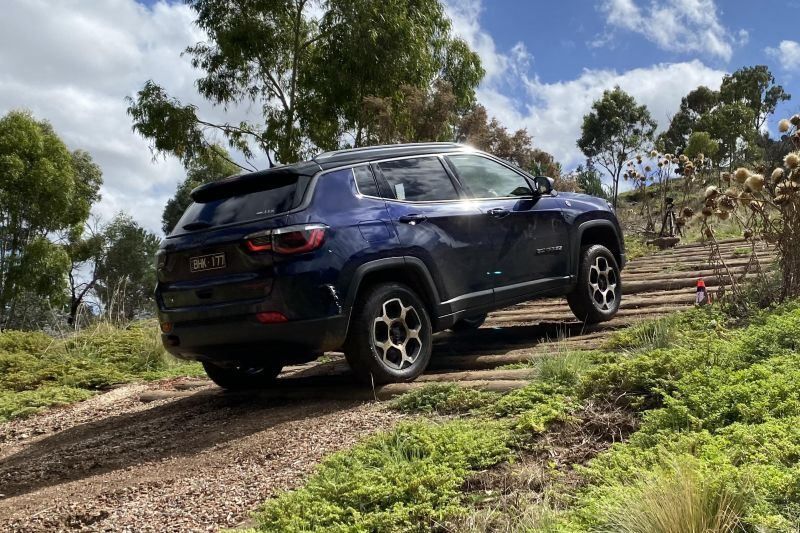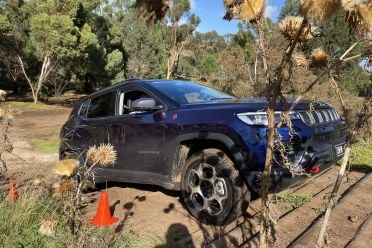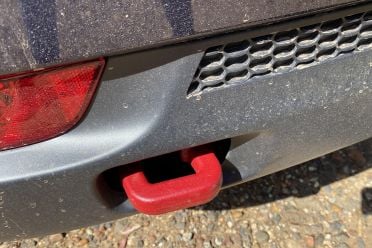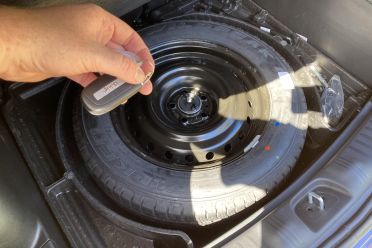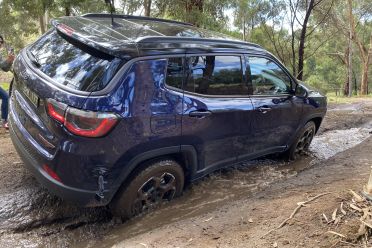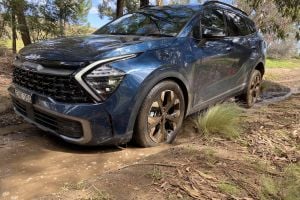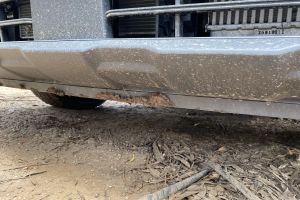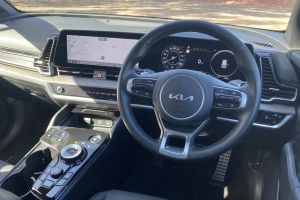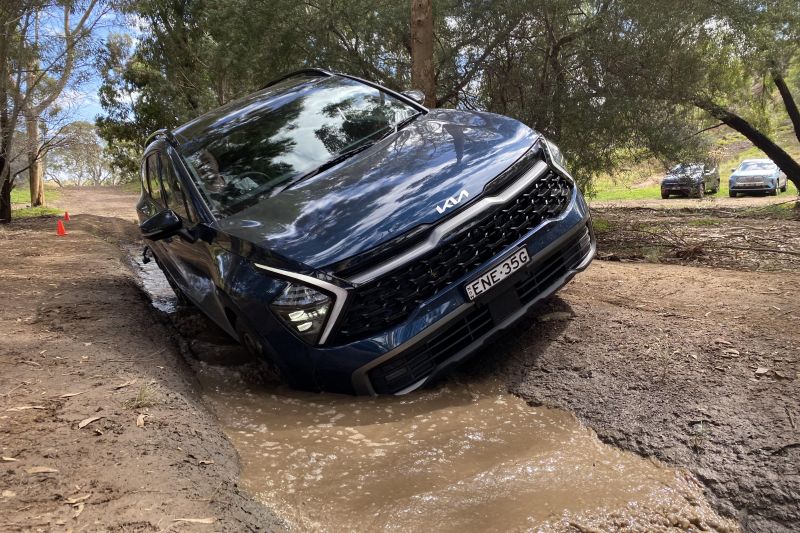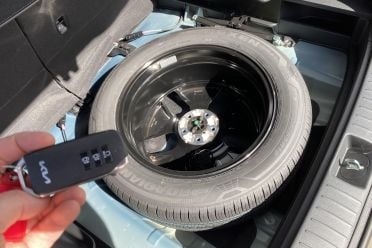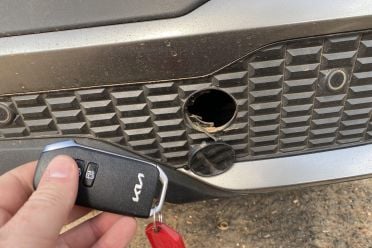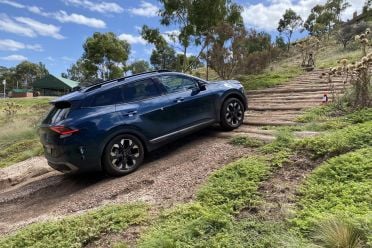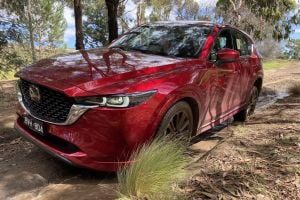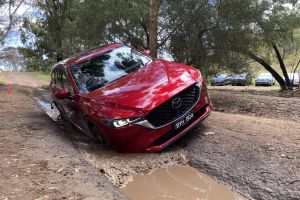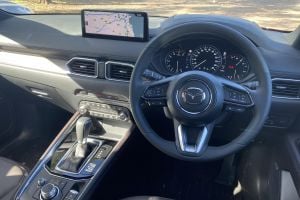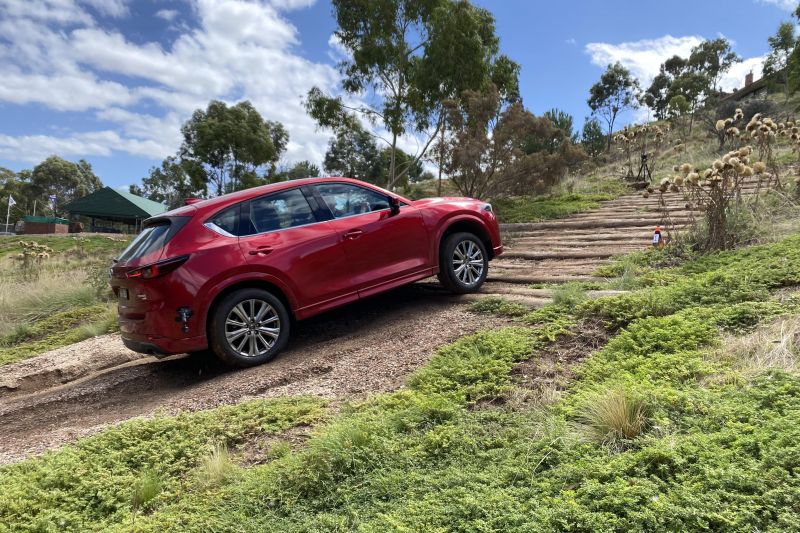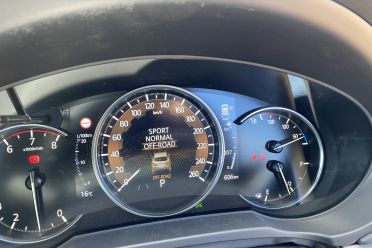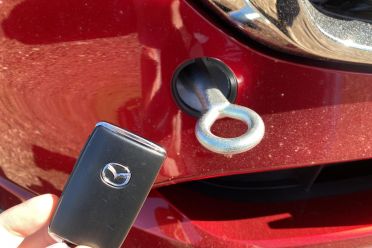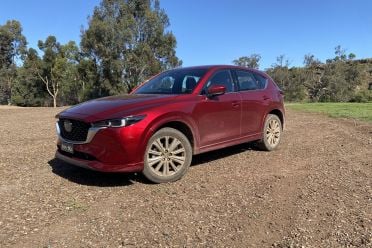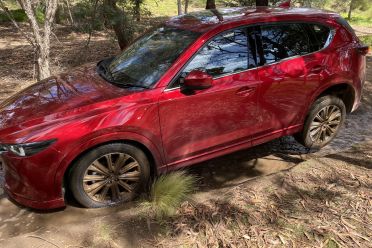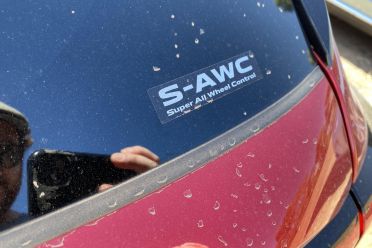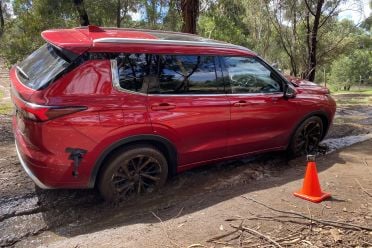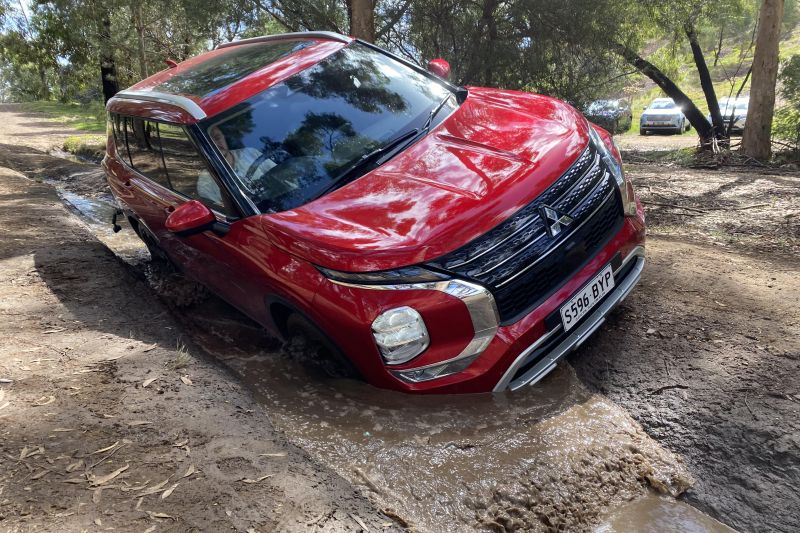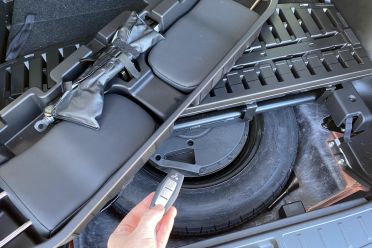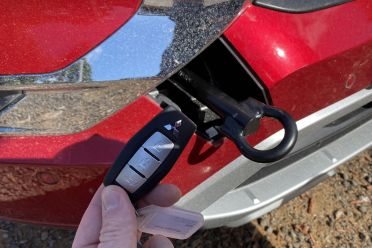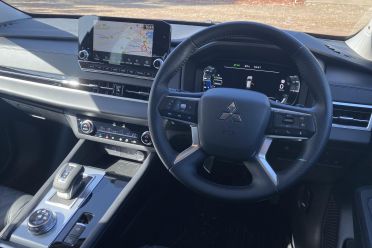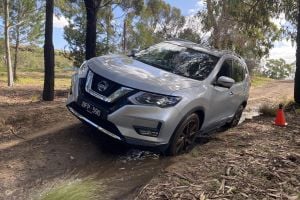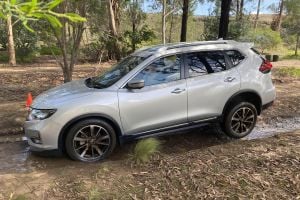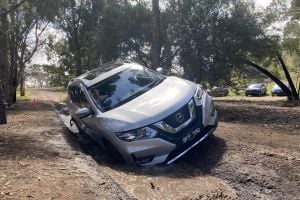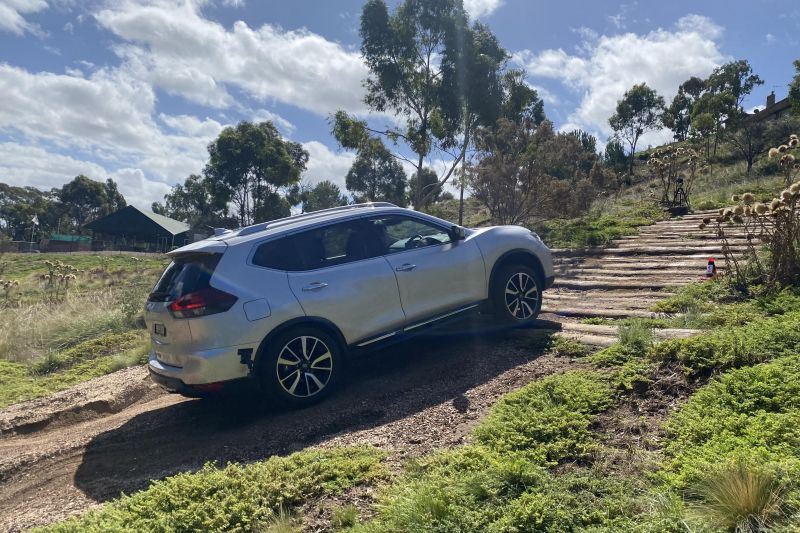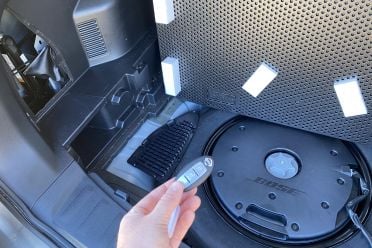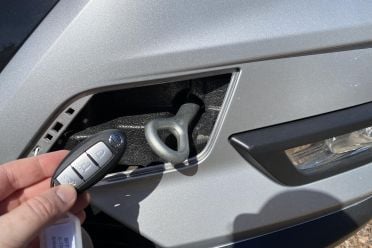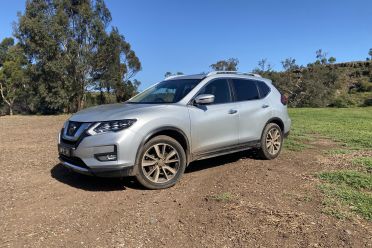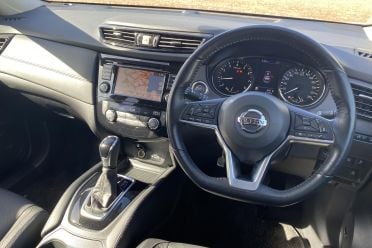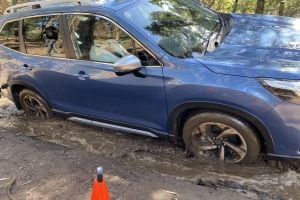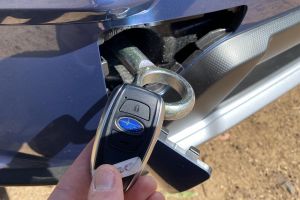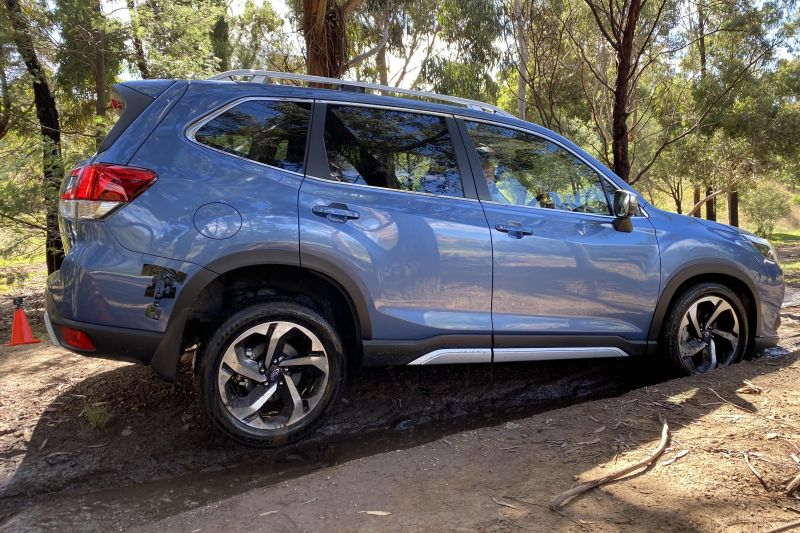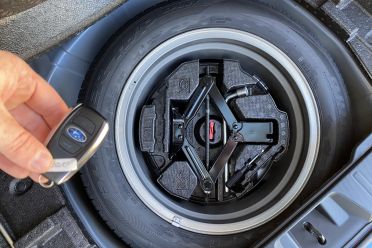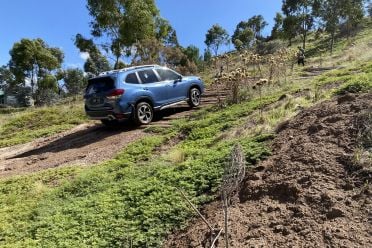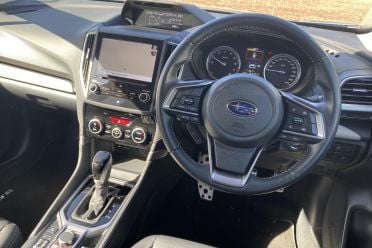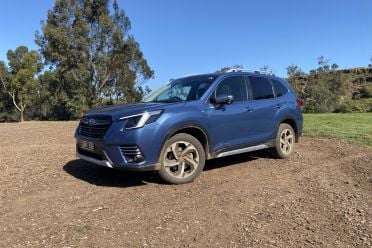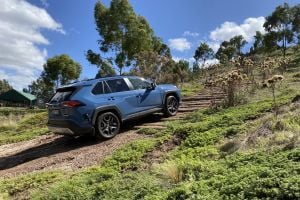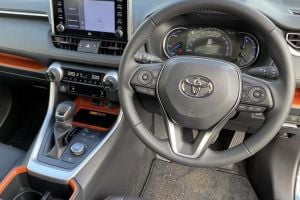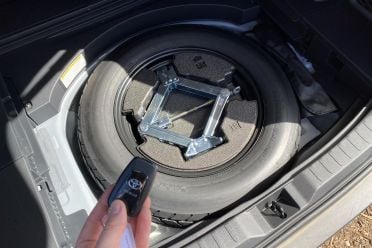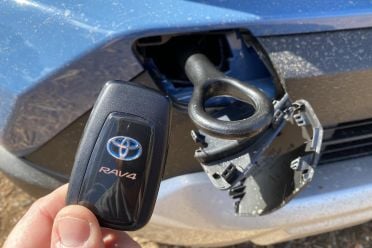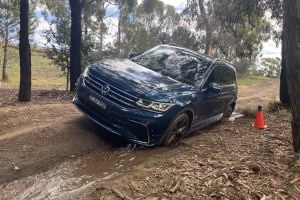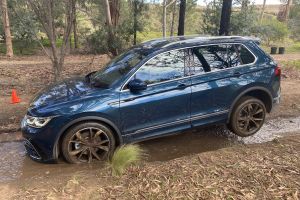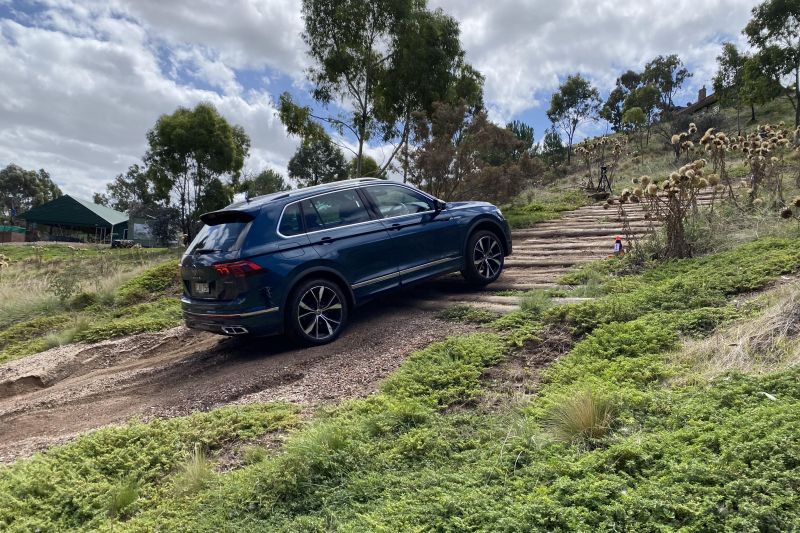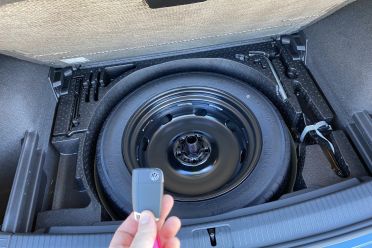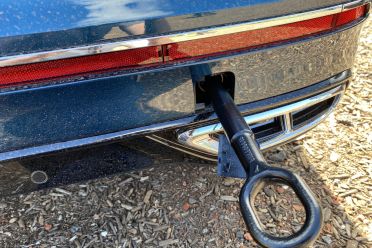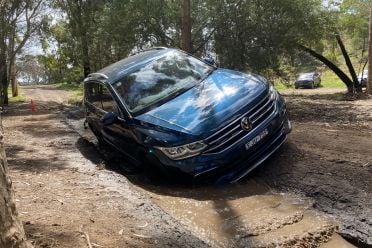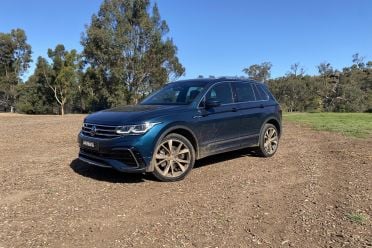Nobody is pretending this line-up of Australia’s top-selling medium SUVs are designed for hardcore, bush-bashing off-road work.
However, we are regularly asked questions around how capable these largely road-focused crossovers are at handling lighter-duty all-terrain stuff – like what you might find approaching campsites etc.
This written article is here largely to supplement the detailed video we’ve just run on our YouTube channel and embedded below, exploring which among the cohort of car-based mid-size SUVs out there can actually handle a little bit of mud – and which can’t.
We’ve settled on this competitor set because they belong to the number-one selling segment, and therefore are of most relevance to the most people. There are a few missing competitors such as the MG HS and Renault Koleos – which were not available.
These are monocoque SUVs with variable (a mixture of electro- and mechanical actuation) four-wheel drive systems, usually as an option that costs extra over a front-wheel drive arrangement. In most cases they bias the front wheels but spin the rear tyres as needed.
Hardcore features like knobbly tyres, locking diffs, real low-range, and live axles are not to be found in any vehicle tested, but features such as downhill-assist control, traction control or surface torque-delivery modes, and torque-split locking setups play a part.
Throughout this written piece we will be regularly referring to the video hosted by Paul, with time stamps specific to the section referred to on the channel page. They are a package deal. All prices used are RRP, before on-road costs, unless stated otherwise.
The tests
The testing procedure used a circuit that was repeated on the same day, in the same conditions, in each vehicle. This was designed to level the playing field as much as possible. It’s very basic but very representative.
The challenge starts with a muddy, rutted trail that challenges each SUV’s clearance, and places them on a roughly 20-degree lean angle. Each vehicle then goes through a rigidity stress-test with two diagonally opposed wheels airborne.
From here each SUV moves to a more steeply side-angled boggy path, full of leaves, giving way to a rise that again reduces the number of tyres in contact with the surface.
After a pause, each vehicle is asked to move forward again, testing how responsive each 4WD system is, and how well-tuned its traction controls and surface modes are.
Then we hit the cheekily named Log Mountain, where we test traction over a series of slippery logs on a continual climb, plus by stopping then re-starting half way up we test the tyre grip, AWD/4WD system, downhill assist, and traction controls.
This is far from hardcore, and any proper 4×4 would walk through this course with ease. But we think it’s a fair representation of what certain SUV customers might expect their vehicle to handle. So, which ones did?
Side note: We did the same loop separately in the Nissan X-Trail locked in its 2WD setting, and it didn’t make it, proving that AWD was a requirement. Each vehicle was driven at the tyre-pressures recommended by the manufacturer.
Ford Escape
The Ford Escape is a bit of a forgotten player in the market, with a lack of badge recognition and tight supply both denting sales. Here we borrowed the flagship Vignale spec at $49,950 before on-road costs.
It’s a bit of a hot hatch by class standards, with a meaty 183kW turbocharged petrol engine giving it some real straight-line hustle.
Its “intelligent” 4WD system is responsible for pushing engine outputs more rearwards when slip sensors are engaged, and like competitors it also has button-controlled traction modes that adjust the power delivery to suit – namely snow and sand.
Flicking through the various traction modes changes the digital instrument cluster display, so you know where you stand. It had no dramas with the flex test, and cleared the obstacles – though note the ST-Line grade has 12mm less clearance.
Squeezing onto throttle with a tyre airborne proved little impediment, with the Ford’s driveline clearly mitigating the rear-right wheel from mindlessly spinning. With little fuss and in little time, it just rolled on through.
It scrabbled a little up a sandy slope and the firm suspension didn’t maximise comfort. Upon restarting half way up Log Mountain, with a flat throttle, it was unable to clamber its way up. It also overheated the AWD system as per the error warning – no orphan in this regard.
- Engine: 2.0-litre turbo petrol
- Outputs: 183kW and 387Nm
- Transmission: 8-speed auto
- Driven wheels: Four
- Length: 4620mm
- Clearance: 190mm
- Tyres: Continental Premium Contact 245/45 R20
- Spare wheel: Temporary
Haval H6
This fast-growing Chinese contender is racking up big sales on the back of keen pricing and sensibly handsome design. The Ultra AWD driven here retails for $42,990 drive-away.
Its 2.0-litre petrol engine makes a solid 150kW and 320Nm, but it uses a dual-clutch transmission that isn’t always suited to off-roading. It also has a limited 170mm of ground clearance – less than all competitors.
You get various surface-specific traction modes called Sand, Snow and Off Road, but oddly they’re controlled through a touchscreen menu.
We weren’t expecting much to be honest, which is why we came away quite surprised!
Its lack of clearance resulted in scraping but no beaching, and it had zero issues with the chassis rigidity test. It did get through the offset mogul section with two diagonally opposed tyres lacking grip, but there were a number of clunks and driveline shunts before doing so.
It fared far better on Log Mountain, performing the above-average feat of clambering up after stopping half-way despite its slightly jerky DCT, indicating well-tuned traction control and responsive 4×4 systems. It was actually one of the best here at this test.
- Engine: 2.0 turbo petrol
- Outputs: 150kW and 320Nm
- Transmission: 7-speed DCT
- Driven wheels: Four
- Length: 4653mm
- Clearance: 170mm
- Tyres: Hankook Ventus S1 225/55 R19
- Spare wheel: Temporary
Honda CR-V
The Honda CR-V has long been a favourite on account of its unusually flexible interior, great back seats, and loyal Honda buyers.
But it’s never really been one to proudly lean on any 4×4 cred, as its relative lack of configurable traction modes and other electrical helpers indicates. You do, however, get a cool active AWD system diagram in the cluster and a full-size spare wheel.
It has a 1.5-litre turbo-petrol engine with solid-yet-unspectacular 140kW and 240Nm outputs, and a CVT. The flagship VTi-LX AWD retails for $53,200 drive-away, since Honda doesn’t advertise the RRP.
It has decent clearance, and nailed the chassis rigidity test. Once teetering with two tyres lacking surface contact and the traction control lighting up, Paul re-applied throttle and… there was engine noise and spinning wheels, with no forward progress.
With a little more steering applied and carrying some momentum, it passed through, but it certainly struggled a little. It felt gentle and comfortable up Log Mountain, but upon restart (with the torque delivery monitor display active) it went nowhere.
Manually switching off the traction control in lieu of a traction-surface mode didn’t help, and its drivetrain really demanded momentum to get places.
- Engine: 1.5 turbo petrol
- Outputs: 140kW and 240Nm
- Transmission: CVT
- Driven wheels: Four
- Length: 4635mm
- Clearance: 208mm
- Tyres: Michelin Latitude Sport 235/55 R19
- Spare wheel: Full-size
Hyundai Tucson
The Hyundai is mechanically the same as the Kia Sportage discussed further down, and has the same engine range. We’re testing the range-topping Highlander diesel at $52,400.
As well as offering a punchy diesel with lots of low-down torque, it has Snow/Mud/Sand traction modes under a Terrain menu controlled by a rocker switch unlike the Kia’s rotary dial, downhill assist, and a full-size spare wheel.
It’s worth noting the diesel has a torque-converter automatic transmission rather than the petrol/AWD’s dual-clutch-type transmission, which is less linear and harder to modulate off-road.
No issues with the chassis rigidity test, no issues there. It shares its modest 181mm ground clearance with the Kia, and while no big scrapes were felt, the front bumper clipped a little mud.
Upon restart after sitting with the two diagonally-opposed wheels airborne, the Tucson’s on-demand system and traction controls struggled for a bit to get it rolling, working harder than some here, but like its twin it did make it.
The road rubber didn’t love clambering up Log Mountain, although unlike the Kia it marched to the half-way point without hesitation and eventually upon restart the traction mode system got us moving again. Paul found the downhill brake pedal feel could’ve been better.
Oddly the Kia didn’t achieve the same, but since they are identical vehicles beneath the different bodies, it’s possible Paul’s line was minutely different or something.
- Engine: 2.0-litre turbo diesel
- Outputs: 137kW and 416Nm
- Transmission: 8-speed auto
- Driven wheels: Four
- Length: 4630mm
- Clearance: 181mm
- Tyres: Nexen Roadian GTX 235/55 R19
- Spare wheel: Full size
Jeep Compass
The Jeep is a bit of an outlier here in terms of dimensions: at 4398mm long it’s the smallest vehicle on test. The tested grade is the Compass Trailhawk, which sits at the top of the range at $52,650 before on-road costs.
The Trailhawk name means it’s “trail rated” in the US, so despite its car-like underpinnings it purports to have some off-road cred.
It has the most clearance of any contender here at 225mm and uses an off-road friendly diesel engine with outputs of 125kW and 350Nm, paired to a nine-speed auto. It also has hill-descent control, prominent red rescue points bolted on, and some underbody protection.
It has features such 4WD that can disconnect the rear wheels on tarmac, a first gear in a nine-speed auto that impersonates low-range, a button to lock torque distribution front and rear; and a switch to enable traction control profiles suited to sand, mud, rocks or snow.
In our testing we found the chassis flexed over the relevant test site, and as Paul shows you this means the doors proved harder to open. But is clearance enabled to it cruise over obstacles that caught some others on the front lip or from low-hanging componentry.
Rolling back onto the throttle after being stationary with diagonal wheels lacking traction, it rapidly shuffled around the torque and “effortlessly” crawled through after engaging the rear axle and mitigating slip.
On log mountain, like many others here it failed to clamber up the hill after stopping, and after a few seconds of trying even displayed a ‘Service 4WD System’ error message. Reversing down, then tracking back up with some speed and not stopping, proved an easier challenge.
Paul found the hill-descent control very good, and for less-experienced drivers this tech helps you stay off the brakes so much.
- Engine: 2.0 turbo-diesel
- Outputs: 125kW and 350Nm
- Transmission: 9-speed auto
- Driven wheels: Four
- Length: 4398mm
- Clearance: 225mm
- Tyres: Falken Wildpeak 225/60 R17
- Spare wheel: Full-size steel
Kia Sportage
The Kia is mechanically the same as the Hyundai Tucson, and has the same engine range. We’re testing the range-topping GT-Line diesel at $52,370.
As well as offering a punchy diesel with lots of low-down torque, it has Snow/Mud/Sand traction modes under a Terrain menu, downhill assist, and a full-size spare wheel.
It’s worth noting the diesel has a torque-converter automatic transmission rather than the petrol/AWD’s dual-clutch-type transmission, which is less linear and harder to modulate off-road.
No issues with the chassis rigidity test, and Paul raved about how crisp the surround-view camera resolution proved. It shares its modest 181mm ground clearance with the Hyundai, and while no major scrapes were felt, the front bumper did rub some mud, unlike most rivals.
Upon restart after sitting with two diagonally-opposed wheels airborne, the Kia’s on-demand AWD and traction controls did struggle momentarily to get it rolling, working harder than some.
The Kia’s road rubber and traction control didn’t love clambering up Log Mountain, and got nowhere upon restart. It also delivered an error message. The only way to get up the loggy slope was the carry more momentum once the warning cleared.
- Engine: 2.0 turbo-diesel
- Outputs: 137kW and 416Nm
- Transmission: 8-speed auto
- Driven wheels: Four
- Length: 4660mm
- Clearance: 181mm
- Tyres: Nexen Roadian GTX 235/55 R19
- Spare wheel: Full size
Mazda CX-5
The Mazda CX-5 is an enduring top-seller, but is popular largely due to its on-road manners and premium feel.
There are naturally aspirated petrol and twin-turbo diesel engine options, but here we have the 170kW turbo-petrol with a substantial 420Nm of torque. The grade tested is the flagship Akera at $53,380.
It uses an on-demandAWD system with slip sensors, as well as incorporating a new Off Road traction mode in the rocker switch-controlled drive mode menu, limiting wheel slip.
Paul was impressed with the camera display in the new (for 2022) screen, and its solid 200mm of clearance and comparatively compact dimensions. As with most vehicles in test, no dramas with the chassis rigidity test.
Shimmying the CX-5 out of a tight spot with the two diagonally opposed wheels lacking traction was a matter of steady, progressive throttle inputs, with Paul commenting that the system’s traction control approximated a slip-reducing diff.
Its comfortable ride was evident heading up the logs, but unfortunately it failed to clamber up after stopping half-way – despite teasing up. Its AWD system didn’t show an error message, but did flash a warning saying it was under high levels of load.
- Engine: 2.5-litre turbo-petrol
- Outputs: 170kW and 420Nm
- Transmission: 6-speed auto
- Driven wheels: Four
- Length: 4575mm
- Clearance: 200mm
- Tyres: Toyo Proxes 225/55 R19
- Spare wheel: Temporary
Mitsubishi Outlander
The $48,990 Mitsubishi Outlander Exceed AWD is one of the newest designs here, though its naturally aspirated engine outputs aren’t anything special. At 4710mm long it’s also the largest vehicle here, with a long wheelbase which is good for stability.
It comes with on-demand 4WD branded Super All-Wheel Control by Mitsubishi, with various terrain modes controlled by a chunky rotary dial and an ability to modulate accelerator input and braking force at each corner of the vehicle.
The dedicated soft-surface modes are called Gravel, Snow and Mud, and they change the graphics on the larger digital cluster. There is also a hill-descent control system.
The Mitsubishi cruised through the early part of the course and demonstrated good chassis rigidity, but after stopping with two diagonally-opposed tyres airborne, the S-AWC system took a few seconds to shuffle torque around to pull the vehicle out. But, it did it.
Paul found the throttle tune a little uneven and the parking sensors quite intrusive. Upon restart half way up Log Mountain, it managed to clamber up after a few tries, neither flaring the CVT or giving any warning lights.
In terms of ride comfort, we found the suspension a little firm, which doesn’t always mean maximum comfort for occupants.
- Engine: 2.5 petrol
- Outputs: 135kW and 245Nm
- Transmission: CVT
- Driven wheels: Four
- Length: 4710mm
- Clearance: 210mm
- Tyres: Bridgestone Ecopia 255/45 R20
- Spare wheel: Temporary
Nissan X-Trail
The Nissan X-Trail is well overdue for replacement with a new-generation model, but the outgoing model is at least competitively priced at $46,115 for the TI 4×4 range-topper.
It runs a fairly low-power 126kW 2.5-litre naturally aspirated engine mated to a CVT, but has an above-average 210mm of ground clearance.
Drivers are greeted by a chunky dial with Auto 4×4 setting, plus novel 2WD-only mode and a Lock mode that sets a front to rear even torque-split. There’s also a downhill-braking assist system.
Despite being the oldest platform here, there were no issues with body rigidity. With the rear-right wheel cocked, and rolling onto throttle, it took some time for traction control to really pull the vehicle through.
The aspirated engine and CVT calibration isn’t rapid, but responsive down low in such a way that suits light 4×4-ing.
It failed to make it to the top of Log Mountain after a half-way restart, even in Lock mode that fixes torque split. Flat to the floor, all four wheels spun, and it nearly made it. But didn’t.
- Engine: 2.5 petrol
- Outputs: 126kW and 226Nm
- Transmission: CVT
- Driven wheels: Four
- Length: 4690mm
- Clearance: 210mm
- Tyres: Bridgestone Ecopia 225/55 R19
- Spare wheel: Temporary
Subaru Forester
We’re expecting a lot from the Forester, because Subaru has built its brand on solid all-wheel drive abilities. Unlike rivals the Forester is only available with AWD, and in 2.5i-S grade as tested here costs a very reasonable $44,190.
It comes with a symmetrical AWD system that’s always operational rather than strictly on-demand (proactive, not reactive), and so ought to rapidly respond to challenges. Its above-average 220mm of ground clearance should also help.
It also comes with two so-called X Modes designed to power the vehicle more effectively on snow and mud, downhill assist control, and some nifty helpful aids such as roll angle diagrams and a kerb-view camera display. There’s no low-range (transfer case) in this generation.
Behind the wheel you have a terrific sense of spaciousness, thanks to the big windows.
It aced the door rigidity test without fuss, rolled smoothly over the bog hole, and was able to rapidly and decisively get moving again after teetering with diagonal wheels in the air, with minor throttle.
It also impressed after stopping half way up Log Mountain, with the primed AWD system and clever electronics pulling it up with absolutely no fuss at all, belying its road-biased rubber. It’s going to be hard to top…
- Engine: 2.5 petrol
- Outputs: 136kW and 239Nm
- Transmission: CVT
- Driven wheels: Four
- Length: 4640mm
- Clearance: 220mm
- Tyres: Bridgestone Dueller 225/55 R18
- Spare wheel: Full size
Toyota RAV4
The RAV4 is Australia’s top-selling SUV, and is tested with the hybrid engine chosen by the overwhelming number of buyers – though the $52,700 Edge grade tested also comes with a 2.5-litre petrol-only engine option with mechanical AWD.
It uses a petrol engine plus a front axle motor-generator for most driving, using an e-CVT. But when called upon its onboard brain can tap into a smaller-output motor on the rear wheels, which gives it a novel variety of AWD sans driveshaft.
It comes with a Trail mode which gives you a cool little rock graphic and can supposedly alter throttle, wheel braking and torque distribution to enhance traction on low-grip surfaces.
It got off to a good start, showing good chassis rigidity, while the traction control got busy early on –alongside various warning chimes going off due to the obstacles and shallow puddles.
The total lack of engine noise (hybrids are all-EV at crawling speeds) was a very obvious differentiator too, and I’m sure the local wildlife appreciated it.
Once teetering, with diagonally-opposed wheels in the air, Paul leaned back onto the throttle, with the result being the airborne tyres continuing to spin for a sec while the traction system worked out how best to apportion torque to where it might be useful. Perhaps not as rapid as an e-pulsing rear motor AWD system might suggest…
It also battled upon restart half-way up Log Mountain, first rolling back a bit, then flaring the engine and spinning the tyres without finding a surefooted route. It did manage to make it up with momentum, but Paul found the throttle had to be firmly applied.
- Engine: 2.5 two-motor hybrid AWD
- Outputs: 163kW
- Transmission: e-CVT
- Driven wheels: Four
- Length: 4615mm
- Clearance: 195mm
- Tyres: Bridgestone Alenza 235/55 R19
- Spare wheel: Temporary
Volkswagen Tiguan
The Tiguan 162 TSI R-Line costs $55,990 and uses a 2.0-litre turbocharged petrol engine from the previous Golf GTI. There’s also a torquier 147 TDI diesel available, however. Both use VW’s signature DSG dual-clutch transmission.
The Tiguan is the most mechanically sophisticated SUV here with adaptive damping available, with dial-operated soft-surface traction modes built into the minutiae of the driver profile selector page, and diagrams in the centre display (compass, altimeter, roll angle meter etc).
You can go quite granular, changing the parameters of things such as hill-descent control, and the 4Motion’s AWD behaviour, through the touchscreen.
No dramas with the rigidity test, and once the parking sensors were switched off it was fuss-free through the moguls. With the wheels cocked, it needed a few pushes on the throttle pedal to pull it out, but the DSG’s smoothness in this application was surprising.
Like various others it failed to make it up Log Mountain after stopping half way, which I suspect was down in large part to the road rubber on big wheels. Luckily the hill-descent control worked in reverse.
Despite needing momentum to make it up the hill, its lack of any error warnings or DSG bugs, as well as its decent clearance, made it a solid enough performer.
- Engine: 2.0 turbo-petrol
- Outputs: 162kW and 350Nm
- Transmission: 7-speed DSG
- Driven wheels: Four
- Length: 4509mm
- Clearance: 201mm
- Tyres: Pirelli Scorpion 255/40 R20
- Spare wheel: Temporary
Summary
The gist? The Subaru Forester was the best of the bunch here when asked to tackle light-duty soft-roading.
Commendations go to the Haval, Hyundai and Mitsubishi for their performance on Log Mountain too, and to the Ford for its performance on the moguls.
Paul expressed disappointment in the Jeep and Toyota, in particular, and the Honda too – although its off-road claims are less lofty.
As to the question of whether you should spend up on the AWD option over the FWD, then the answer as proven by our control vehicle is, yes!
Again, be sure to watch the video above for the full picture. The conclusion is time-stamped at 43 minutes and 44 seconds.



